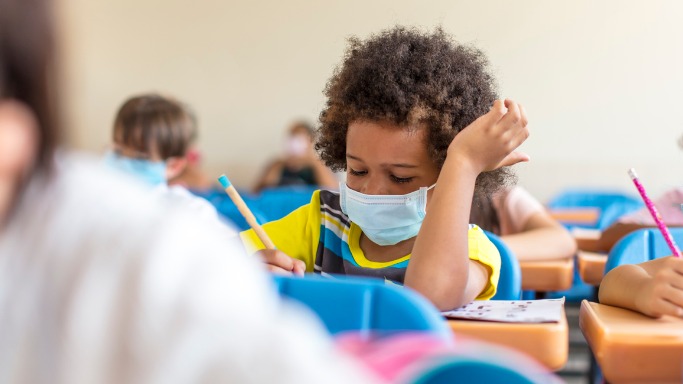This is the second of a three-part series.
Kids are suffering academically, emotionally and mentally during this pandemic, especially minority students. Educational gaps were narrowing prior to the coronavirus outbreak. Now, they grow wider as each month of full virtual learning passes.
Unless parents and policymakers stand up to the labor interests that are more concerned about their partisan wishlists than children’s education, poor and minority students will keep falling behind, eventually unable to catch up.
We are approaching a year since many school systems shut down and forced children into full-time virtual learning. Last fall, private schools resumed in-person instruction safely, but large public school systems around the country remain closed. Some still have no reopening plans in place 12 months later.
If children are the future, what kind of future do we face given the setbacks so many of them have endured waiting for schools to resume in-person learning?
Remote learning in and of itself is not a failure. Online charter schools have demonstrated success in closing the achievement gap between students of means and those without. But virtual classrooms aren’t the best option for many students, especially as they’ve been implemented by public schools and forced on unprepared families.
Public school systems were slow to incorporate virtual learning before the pandemic and woefully unprepared to shift to online education in the early days of this virus outbreak. We’ve seen many states and school districts improve their online remote learning environments.
However, early on we witnessed the cruelty of the unions: When teachers tried to implement creative ways to teach, teachers’ unions forbade online instruction.
The outcome for Black and Hispanic students is devastating. Students of color may be six to 12 months behind in learning, compared with four to eight months for white students. Minority students are more likely to remain in remote learning, but less likely to have access to the tools for learning in a remote environment such as devices, internet access and live contact with teachers.
Parents gave their school systems grace at the start of the pandemic, but nearly a year later, they are right to be angry and frustrated about the lack of leadership, planning, and will on the part of school administrators to prioritize their children’s education over the demands of teachers unions.
Teachers may be concerned about the health risks of in-person learning, but a body of scientific evidence from other countries and the U.S. (along with health officials) confirms that children, especially younger ones, can safely return to school and instruction should resume.
Yet teachers’ unions refuse, placing themselves ahead of poor and minority kids. In many states, teachers are being given priority for vaccines, even over other essential workers who are already providing services in-person. And yet still the teachers’ unions are refusing to return to the classrooms, even after having access to vaccinations.
Some Black parents are apprehensive about in-person instruction. They still deserve to choose whether to send their children to school or not instead of having that choice made for them. But they need to have that choice and ensure that their children have access to quality education.
During Black History Month, as we reflect on the achievements of Blacks, we can attribute that progress to education. During Reconstruction, Black communities nationwide came together in partnership with philanthropist Julis Rosenwald and innovator Booker T. Washington to build thousands of schools for their children. They did so even in the face of the most severe racism because they were committed to combating illiteracy and education gaps.
Over a century later, the pursuit of quality education for Black students marches on. Parents and policymakers must confront the forces working against our children and fight for more choice in education.
Chicago’s Mayor Lori Lightfoot provides an example of leadership and courage on this issue. Lightfoot prevailed in a bitter battle against the Chicago teachers’ union over reopening schools.
Lightfoot is far from a conservative firebrand, but she understood the toll that protracted school closures take on the students, over 90% of whom are non-white. She noted, “A big part of this fight for me, and really the primary focus, was on student achievement. Not just grades, but really social-emotional learning as well. … And I see the educational gaps that are just widening in a remarkable and frightening way for Black and Latinx students. … Every single day, 30,000 students just don’t log on.”
Los Angeles and San Francisco officials are also so fed up that they are suing the school systems to get kids back into school. We need more policymakers pushing school systems to reopen, not conditioned on a bevy of unrelated demands, but because it is important for the health and success of their children.
Parents have a critical role to play. They must keep advocating for their schools to reopen, but they should also push policymakers to expand the choices their children have to obtain an education. Now is the time for more school choice.
Large majorities of Black and Hispanic parents indicate that they are open to public school alternatives such as homeschooling and private schools. However, many families lack the financial resources to do so.
States are enacting reforms to expand school choice. For example, 26 states, Washington, D.C., and Puerto Rico offer private school scholarships to over half a million students. In response to the pandemic, governors have sought to do more, such as using federal emergency funding to expand virtual education options.
Black and Hispanic parents should demand that states continue to innovate in expanding educational options. Even more, they should advocate for more control over how to use federal resources for their children.
The damage to children’s learning is undeniable. It’s time for parents and policymakers to exert pressure on school administrators and unions. The futures of their children depend on it.

